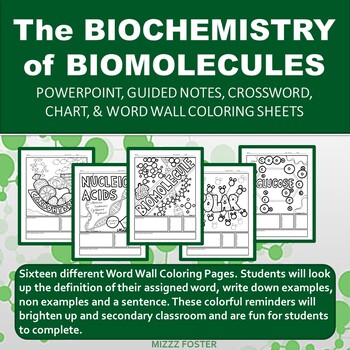The Biochemistry of Biomolecules Powerpoint, Foldable, Word Wall, and more!
Products in this Bundle (5)
Also included in
- CHNOPS & Biochemistry of Biomolecules Bundle comes with two PowerPoint presentations, two differentiated sets of Guided Notes in Worksheet and Foldable styles, a crossword puzzle, a comparison chart, CHNOPS worksheet, and 16 Word Wall Coloring Sheets. The guided notes are in print and digital foPrice $25.00Original Price $40.25Save $15.25
Description
The editable PowerPoint and graphic organizer foldable can be taught alongside each other as guided notes. The information the students need to record is in a large bold font. There are also plenty of opportunities to simply listen to the instructor and look at examples.The sixteen word wall coloring sheets are great to reinforce vocabulary while adding student work to your walls.
Powerpoint (editable):
The Biochemistry of Biomolecules PowerPoint Presentation can be used to introduce biomolecules or review biomolecules.
The presentation begins with an overview of monomers, polymers, dehydration synthesis, and hydrolysis. Students will also write about molecule classifications and interactions in water.
Next each biomolecule group; carbohydrates, lipids, proteins and nucleic acids are presented with their characteristics, energy levels and examples of their monomers and polymers. Students should be able to identify characteristics of each group, the monomers, polymers, energy, molecular shapes, and nomenclature.
The Biochemistry of Biomolecules Graphic Organizer Fold-out Foldable:
The Biochemistry of Biomolecules Fold-out Foldable can either be used as a way to introduce biomolecules or review biomolecules.
The foldable begins with an overview of monomers, polymers, dehydration synthesis, and hydrolysis. Students will also write about molecule classifications and interactions in water.
The centers of the foldables have dedicated spaces for notes on carbohydrates, lipids, proteins and nucleic acids. Students should be able to identify characteristics of each group, the monomers, polymers, energy, molecular shapes, and nomenclature.
Included are four files. One is a simple blank student notes, a modified student notes which is in the fill in the blank style, a red ink teacher's notes and a black ink teacher's notes for students who require teachers notes or were absent. A quick note on assembly instructions is also included.
Biochemistry and Biomolecule Word Wall Coloring Sheets:
Coloring pages have recently become a huge hit all over the world. In my new series of word wall coloring pages, you can bring the excitement of coloring into your middle school and high school science classrooms.
This set includes the words: CHNOPS, Biomolecules, Monomer, polymer, dehydration synthesis, hydrolysis, nonpolar, polar, carbohydrates, glucose, lipids, fatty acids, proteins, amino acids, nucleotides, nucleic acids and a blank sheet.
Related Resources:
The Biochemistry of Biomolecules Foldable Graphic Organizer for INB
The Biochemistry of Biomolecules Power Point Presentation
Biomolecules / Biochemistry Word Wall Coloring Sheets (16 pages)






